It will soon be the start of the summer term and for many Key Stage One teachers this means one thing: time for the Statutory Assessments or SATs. Reading is a key part of this process and by the time a child is completing this phase of their education there are a number of skills they are expected to master. Among the list provided in the National Curriculum we find that children should:
- read accurately by blending the sounds in words that contain the graphemes taught so far, especially recognising alternative sounds for graphemes
- read accurately words of two or more syllables
- read further common exception words
- read aloud books closely matched to their improving phonic knowledge, sounding out unfamiliar words accurately, automatically and without undue hesitation
I would also add an additional aspect to reading at this age – it has to be FUN! Being able to read for the sheer joy and pleasure of the story is vitally important. So the books children have access to at this vital stage need to not only support their independence in the mechanics of reading, but also enthuse and engage them.
Looking at the new additions to the Maverick Early Readers at the Gold Band level, I think Year Two teachers will find plenty to support children develop these essential building blocks towards independent reading. Each one is a five chapter book, which will build reading stamina. On top of that they are great stories that are fun to read.
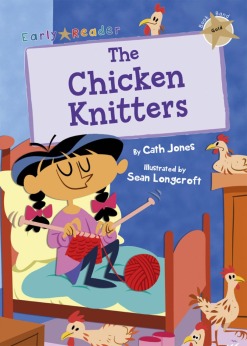 “The Chicken Knitters” by Cath Jones and Sean Longcroft is a rollicking adventure with a host of capable and fast thinking female characters, including the chickens! As I have recently rediscovered the joy of crochet, I was immediately drawn to this title. Lilly, our knitting heroine is determined to save the featherless chickens from the clutches of Farmer Claw. Despite several setbacks, she finally outwits the farmer with the help of the local school knitting champions and Edna McLuskey, the school caretaker.
“The Chicken Knitters” by Cath Jones and Sean Longcroft is a rollicking adventure with a host of capable and fast thinking female characters, including the chickens! As I have recently rediscovered the joy of crochet, I was immediately drawn to this title. Lilly, our knitting heroine is determined to save the featherless chickens from the clutches of Farmer Claw. Despite several setbacks, she finally outwits the farmer with the help of the local school knitting champions and Edna McLuskey, the school caretaker.
Many of the year 2 spelling and grammar expectations feature, providing much needed examples in context. The text also includes plenty of onomatopoeia, which enriches the language experienced by the reader. What I particularly liked is the way environmental and animal welfare issues are carefully integrated into the story. This book would provide a good launch point for discussion around these points. The value of crafts and making things is another aspect which is promoted, and I was pleased to see that the champion knitters included a boy! More perceptive readers may wonder why Lilly herself wasn’t at school, but “The Chicken Knitters” is an engaging chapter book, with a very satisfying and happy conclusion.
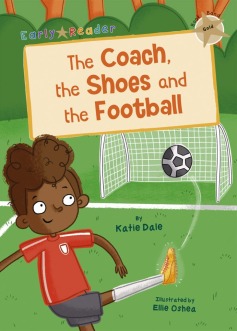
Katie Dale has two new books in the Gold Band. “The Coach, the Shoes and the Football”, illustrated by Ellie O’Shea, is a witty inversion of the traditional Cinderella story. Raj (who is presumably an orphan because his mum is never mentioned) lives with Terry, his uncaring stepfather, and his two dreadful step brothers. All three make Raj’s life miserable and his only hope on the horizon is the summer football camp. Will Raj get to the try outs and impress Coach Prince? Not if Luke and Damon can help it. But despite their efforts and a series of setbacks, Raj is saved by his “hairy Godfather”, Dan, who even provides some sparkly new football boots too.
I liked the way the story references the traditional tale, but makes it a modern version – perfect for prompting similar re-telling of traditional tales from a different angle. It also uses interesting similes and wordplay to stretch the reader. When challenged, Terry turns “as purple as a beetroot,” and there’s also a full on cheesy Cinderella/football joke at the end which should make everyone groan!
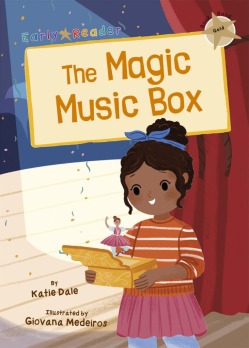
Katie Dale’s second book is “The Magic Music box”, illustrated by Giovana Medeiros.
Bella is desperate to go to ballet school, but there just isn’t any spare cash to pay for it. Bella, however is determined and saves hard to acquire the tutu and shoes she needs. She is also given a magical music box with a dancing ballerina by the mysterious lady in the charity shop. The dancing ballerina inside coaches Bella until she is ready for the talent competition. But things don’t go as the reader may predict – and this is my favourite part of the story. In a time when talent shows are seen as THE way to achieve success, it’s heartening to have a story where hard work and practice are the virtues that get rewarded. In turn, Bella passes on the magical musical box to a dance obsessed boy – another nice twist in this engaging tale.
The story uses alliteration to very good effect, for example, Bella does the cha-cha-cha to the charity shop. There is also a range of descriptive vocabulary which will open up inference questions; when Bella trudges to the charity shop or bites her lip, how is she feeling? The illustrations also open up questions to be explored…just who is the woman from the charity shop?! This is a sweet tale which emphasises how hard work is what will ultimately help you achieve your dreams.
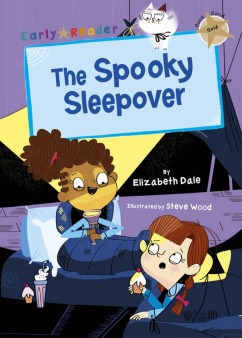 Finally we have “The Spooky Sleepover” by Elizabeth Dale, illustrated by Steve Wood. I was particularly taken with the monochrome illustrations in this book, which seem to bridge between all colour picture books and an illustrated story.
Finally we have “The Spooky Sleepover” by Elizabeth Dale, illustrated by Steve Wood. I was particularly taken with the monochrome illustrations in this book, which seem to bridge between all colour picture books and an illustrated story.
Summer can’t wait to show off her new house to her friends, and nothing, including spooky noises and a mysterious cat, is going to stop the four girls from having fun! Ella is not so sure about the spooky goings on, but her friends are so reassuring that even she takes part in the midnight ghost hunt. The next day the four friends make a surprise discovery, with an even more surprising ending.
This story manages the balance between being scary but not TOO scary very well indeed! The lovely black and white illustrations work well, as the girls explore the night-time house, where every sound is different to the familiar day time world. I also like the way the girls are not reacting in a stereotypical way to the spooky noises and goings on. Summer has a practical explanation for each occurrence, and they all positively relish the idea of holidays spent looking for ghosts! The story builds gently to the final reveal, but still leaves enough room for discussion about what really happened.
All four of these new Gold Band books will give independent readers a challenge and support their writing skills too. Children who are writing at the greater depth standard are expected to “write effectively and coherently for different purposes, drawing on their reading to inform the vocabulary and grammar of their writing“. If these are the books they are reading, then they should be off to a great start.
©Chez l’abeille 2019
Disclaimer: I was provided with copies of the books by Maverick Books. I was not recompensed for this review and all views are my own.













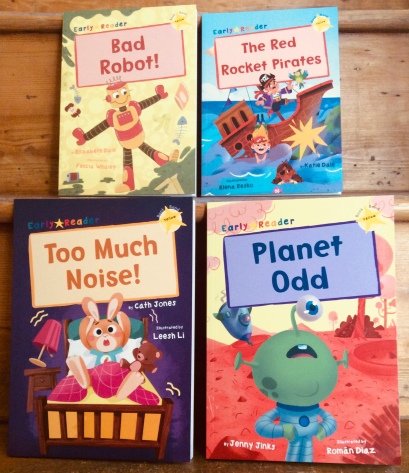 I’m don’t know about you but I’m only just getting my head around the new world order. In a heartbeat what seemed so ordinary, now seems either really hard to achieve or simply not necessary. I seem to be setting myself simple goals on a daily basis – mostly linked to locating ordinary items I would not have given a single thought too in that previous world we inhabited.
I’m don’t know about you but I’m only just getting my head around the new world order. In a heartbeat what seemed so ordinary, now seems either really hard to achieve or simply not necessary. I seem to be setting myself simple goals on a daily basis – mostly linked to locating ordinary items I would not have given a single thought too in that previous world we inhabited.
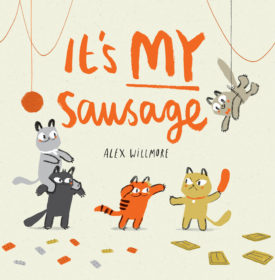 The second book is
The second book is 













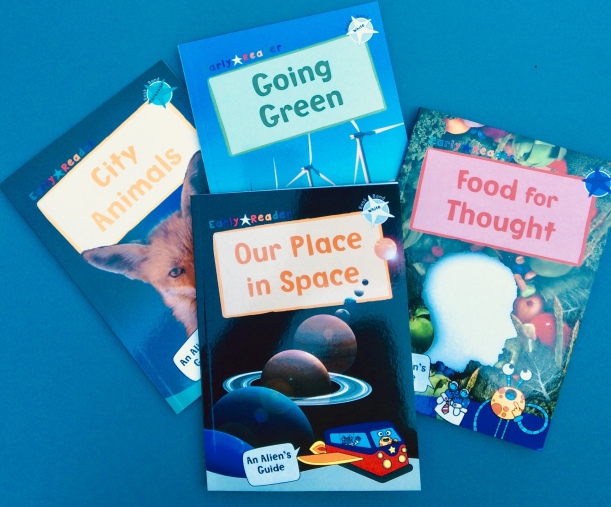 “Going Green” explores how we are finding alternative ways of producing our energy. Covering wind power, wave power and geothermal energy there are a wide range of ideas and information which would provoke discussions about how we are managing our resources. With many schools looking at how they can become more eco-friendly this book should easily find a home in the class library.
“Going Green” explores how we are finding alternative ways of producing our energy. Covering wind power, wave power and geothermal energy there are a wide range of ideas and information which would provoke discussions about how we are managing our resources. With many schools looking at how they can become more eco-friendly this book should easily find a home in the class library.


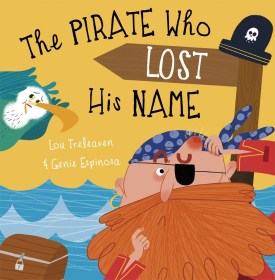 This new book by Lou Treleaven and Genie Espinosa brings a new twist to the pirate genre, and offers some strong curriculum links too.
This new book by Lou Treleaven and Genie Espinosa brings a new twist to the pirate genre, and offers some strong curriculum links too. The story starts quite quietly… Joni is sat on her farmhouse porch, just listening. There’s a stillness that draws the reader in to explore the double spread until you spot the riotous MOO-grass music rising up from the barn. What is going on?
The story starts quite quietly… Joni is sat on her farmhouse porch, just listening. There’s a stillness that draws the reader in to explore the double spread until you spot the riotous MOO-grass music rising up from the barn. What is going on?






















 “The Chicken Knitters” by Cath Jones and Sean Longcroft is a rollicking adventure with a host of capable and fast thinking female characters, including the chickens! As I have recently rediscovered the joy of crochet, I was immediately drawn to this title. Lilly, our knitting heroine is determined to save the featherless chickens from the clutches of Farmer Claw. Despite several setbacks, she finally outwits the farmer with the help of the local school knitting champions and Edna McLuskey, the school caretaker.
“The Chicken Knitters” by Cath Jones and Sean Longcroft is a rollicking adventure with a host of capable and fast thinking female characters, including the chickens! As I have recently rediscovered the joy of crochet, I was immediately drawn to this title. Lilly, our knitting heroine is determined to save the featherless chickens from the clutches of Farmer Claw. Despite several setbacks, she finally outwits the farmer with the help of the local school knitting champions and Edna McLuskey, the school caretaker.

 Finally we have “The Spooky Sleepover” by Elizabeth Dale, illustrated by Steve Wood. I was particularly taken with the monochrome illustrations in this book, which seem to bridge between all colour picture books and an illustrated story.
Finally we have “The Spooky Sleepover” by Elizabeth Dale, illustrated by Steve Wood. I was particularly taken with the monochrome illustrations in this book, which seem to bridge between all colour picture books and an illustrated story.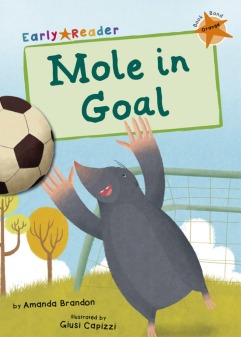 First up then:
First up then: 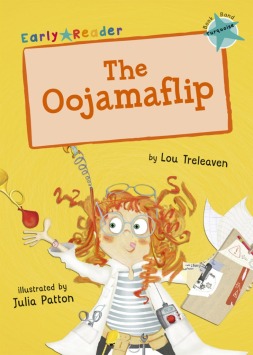 The next three colour bands; turquoise, purple and gold, are all aimed at readers who have developed the required phonics skills and are now building their reading fluency. I was particularly happy to see
The next three colour bands; turquoise, purple and gold, are all aimed at readers who have developed the required phonics skills and are now building their reading fluency. I was particularly happy to see 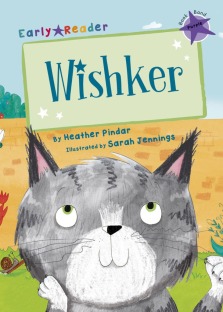
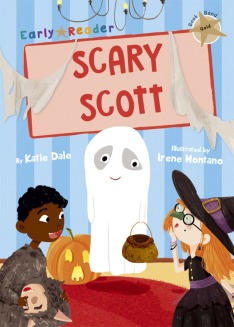 So finally to
So finally to 













You must be logged in to post a comment.